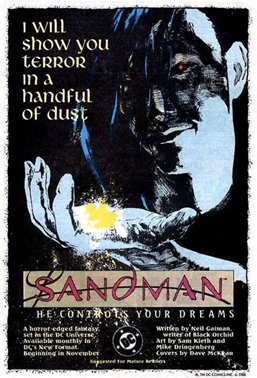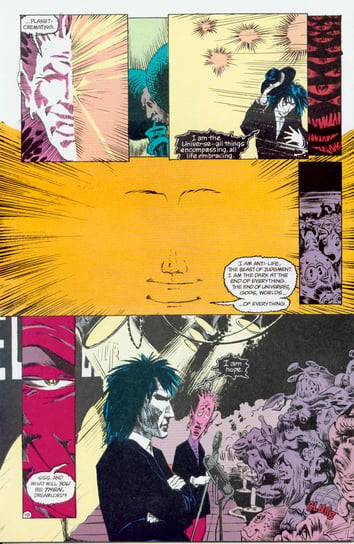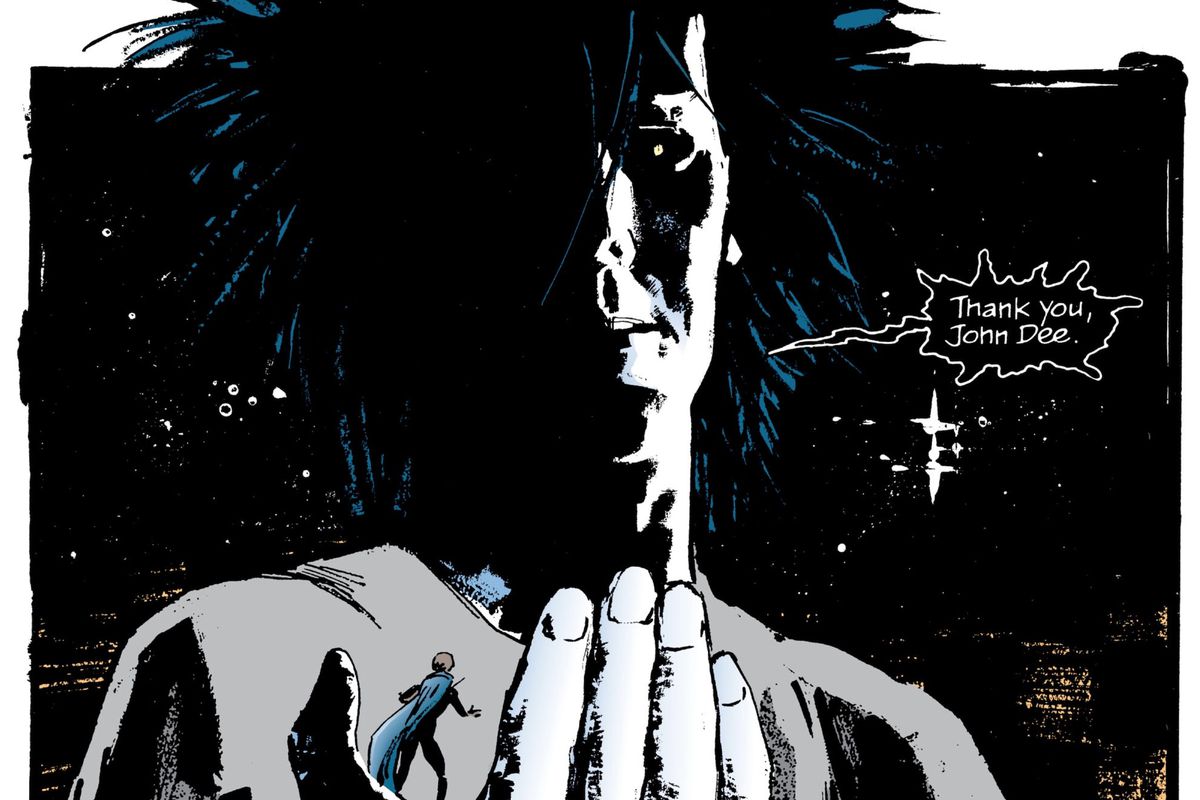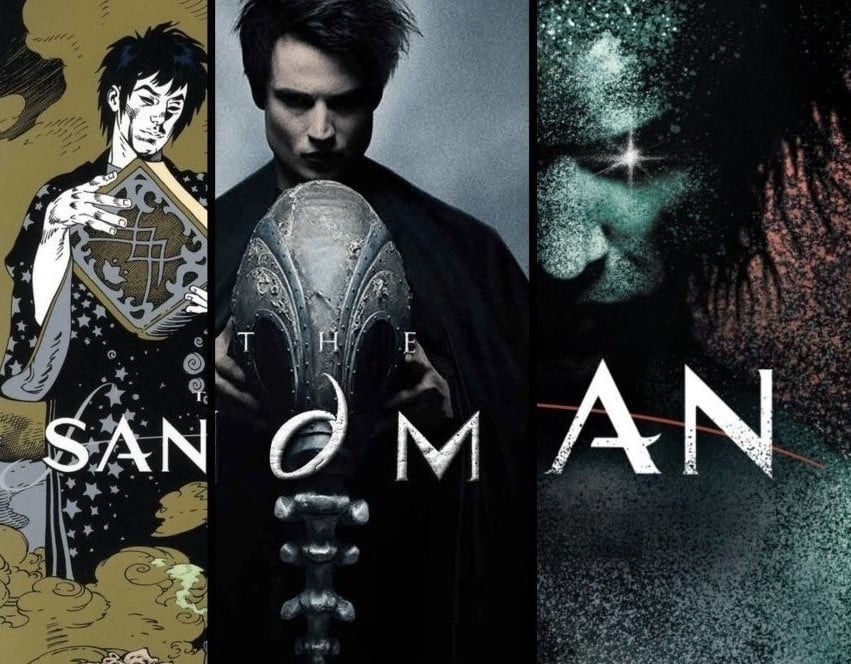Entertainment
Related articles:
1
When I first came across a copy of The Sandman as a teenager in the early 2000s, it evoked an almost religious sense of awe in me.
My older sister was partly to blame for this. She had been hyping the series up for months before we finally got our hands on it, regularly dredging up forum posts, fanart, and any behind-the-scenes information she could get her hands on.
 Beyond her evangelism, though the book was charged in a way that felt impossible to articulate. Its covers were equal parts frightening and wondrous, its stories defied convenient genre categorization, and its myriad mythic references made it feel like the natural culmination of childhoods fuelled by intercultural folklore and legends.
Beyond her evangelism, though the book was charged in a way that felt impossible to articulate. Its covers were equal parts frightening and wondrous, its stories defied convenient genre categorization, and its myriad mythic references made it feel like the natural culmination of childhoods fuelled by intercultural folklore and legends.
It was the perfect storm of pop culture and the arcane, and it made the world feel so much bigger than it was.
Years later, when writing a pitch document in college for my very first play, I appealed to The Sandman’s power to evoke awe as being the primary quality I hoped my story, and any story I write, could carry forward.
I write all this to speak to The Sandman as I knew it, and the ways in which I felt shaped by it because these days, The Sandman is so much more than just The Sandman. Nowadays, it is perhaps best known as the flagship title of Neil Gaiman – a man with as mythic a reputation as any of his characters – and represents a whole universe of content, spanning spin-offs, multimedia adaptations, and even multimedia adaptations of said spin-offs.
Furthermore, I came to find that I was far from the only person whose creative development was massively influenced by The Sandman. It almost felt trite, beyond a certain point, to claim an intimate connection to the work. I briefly retreated from it, embarrassed to admit how much it meant to me to avoid being seen as yet another ‘Sandman person’.
This is where I remained until July 2020, when Audible revealed that Dirk Maggs, the audio wizard behind some of the most ambitious audio shows of the past century, had teamed up with Gaiman to release The Sandman as a lavishly-produced audio series with a stacked cast. The release of The Sandman: Act I was given a level of pomp and splendor rarely afforded to audio dramas – complete with a fancy trailer, subway ads, and almost omnipresent marketing.
Less than half a year afterward, in January 2021, Netflix unveiled the star-studded cast for their own live-action television adaptation of the series. Netflix’s The Sandman topped charts upon its release in August 2022, just one month before Audible’s The Sandman: Act III dropped without any prior announcement.
It was a curious time to be a Sandman fan. There was a case of two excellent adaptations being released almost simultaneously, both made with immense passion and direct involvement of the creator of the original work, jostling for attention in an entertainment landscape that has never been more crowded.
It was all the more curious to see as a creator working in both audio and television because it felt like an unspoken hierarchy of mediums was at play with the two adaptations. Namely: an assumption that the television adaptation was a natural end-state for ‘adapting The Sandman’, with the audio series serving its purpose simply by paving the way for it.
 For an example of this, note this early coverage of the audio series by the New York Times, which characterizes the Audible series as a sort of ‘back-up’ attempt after failing to manifest in a more conventional cinematic form. I also found it striking that, in this interview about his work in audio storytelling, Maggs was asked for his opinion on whether or not the Hitchhiker series would make for a good television series.
For an example of this, note this early coverage of the audio series by the New York Times, which characterizes the Audible series as a sort of ‘back-up’ attempt after failing to manifest in a more conventional cinematic form. I also found it striking that, in this interview about his work in audio storytelling, Maggs was asked for his opinion on whether or not the Hitchhiker series would make for a good television series.
I rarely hear arguments for the listening experience as an end in itself, despite adaptations like this one clearly meriting it on a craft level. For both Maggs and Gaiman, this project was an almost 30-year labor of love, and makes the absolute most of the medium to tell a story uniquely suited to it.
2
Let’s start by asking a basic question: where might the idea of audio as a ‘stepping stone medium’ towards cinematic adaptations come from?
Unsurprisingly, part of it boils down to business. It’s no secret that Hollywood is a fan of leveraging existing IP to try to create ‘safer bets’ at the box office. After all, of the top 50 highest-grossing films at the time of writing, only four are original IP. Of these four, two are Disney films (The Lion King and Zootopia) and two are James Cameron films (Titanic and Avatar), all of which carry their own degree of existing brand recognition already. Everything else on the list is either an adaptation of an existing property, or a sequel.
This goes some way to explain the incredible premium that is placed on the ‘screen adaptation’, and the desperate search for novels, comics, games, and audio that could be ripe for a commercially lucrative ‘big screen treatment’.
TV adaptation rights deals can be the stuff of dreams: immense payouts for work you’ve essentially already done, the potential for a massive new audience to be exposed to your stories, and frankly, the validation of knowing that Hollywood-types think you’ve “got the stuff” – an electric proposition! It’s no wonder that so many burgeoning creators in those fields feel compelled to actively position their work for those sorts of deals, even if the actual reality of attaining one is rarely as rosy as I just laid out.
The tricky thing with audio creators in particular, compared to their peers working in other mediums, is that they rarely if ever have a product which they can sell. Almost every major audio drama is available for free, wherever you get your podcasts.
Audio monetization is incredibly tricky, and something that the industry as a whole hasn’t quite cracked yet. Ad revenue exists, but unless one’s shows are a massive hit, it will rarely be enough to keep the lights on alone. Working with subscription-driven platforms like Audible is another way to receive a healthier influx of capital to produce audio fiction, but these rare opportunities are far from a reliable source of income.
This excellent interview with Travis Vengroff, co-owner of Fool & Scholar Productions and producer of The White Vault, provides a more in-depth look at monetization options available to independent audio drama creators. (Beyond the incredible insight Vengroff presents, the opening line “nothing's hotter right now in the film and television industry than podcasts” should make it a compelling companion read to this one.)
A piece of advice I recently received, as I’ve been working through financial sustainability in my own professional practice, goes something like this:
“Audio dramas, in themselves, are probably never going to make you real money. But they can point towards something else that can make you money.”
That “something else” could take the form of Patreon pages, merch, or, most crucially, the cultivation of IP you believe that Hollywood could be interested in. As Vengroff notes in the earlier interview, film deals are “where many feel the real money is currently made”.
All this is to say that, from a strictly financial perspective: most audio fiction is almost never allowed to be an end in itself.
3
In light of this, I’ve had a growing sense of curiosity with the term “audio movie”. Aside from being one of the many names we’ve taken to using for this medium (see: audio dramas and fiction podcasts), it carries a tacit audacity that I find remarkably interesting.
Some notable usages of the term “audio movie” include ElfQuest: The Audio Movie, London After Midnight, and most relevant to this discussion – is how Maggs refers to his own work (see the section on How The Marquis Got His Coat Back on Maggs' website).
There are a few different ways one could react to the term, depending on how one comes across it. Take this instance from 2021, where the New York Times jubilantly introduced its readership to the ‘entirely novel’ idea of “movies for your ears”, it evokes a sort of bitter cynicism that, half a decade after The Magnus Archives and The Bright Sessions, it would take Hollywood involvement to ‘legitimize’ the medium.
.jpg?width=1200&length=1200&name=podcastmovies-nytarticle%20(1).jpg)
1. The New York Times article about the novel idea of "movies for your ears".
.jpg?width=1200&length=1200&name=washingtonpost_inventedaudiodrama%20(1).jpg)
2. Editor's Note: To be fair, this is not a phenomenon constrained to Hollywood -- popular theaters and academies "hark back to a bygone era" of Oscar Wilde in 1930.
.jpg?width=1200&length=1200&name=npr_inventedaudiodrama%20(1).jpg)
3. Editor's Note: This phenomenon became especially prevalent during the height of the coronavirus pandemic in 2020. If we continued this slideshow, we'd be here all day.
However, there isn’t a trace of that cloying desperation for approval in Maggs’ invocation of the term – quite the opposite. In his own words:
“I don’t think audio, as a medium, need feel inferior to any other medium, because I believe that our medium works just like movies and TV do. The only difference is that the stimulation bypasses the optic nerve.”
In popular discourse about audio storytelling, much is made of the fact that it ‘lacks visuals’. I’ve always found this sentiment to be perplexing – after all, we can’t (and don’t) demand cinematic audio from our comics, or moving pictures from our prose.
In most cases, we are able to meet mediums on their own terms. Each of them offers an entirely unique and specific mode of engagement, enabling certain sensory possibilities while denying others. We generally understand that this doesn’t make one medium better than any other – a quiet read has its place as much as a night at the theater, and every medium has its season.
So what is it about audio storytelling that has us so fixated on visuals it never promised us in the first place? I believe this is actually a question worth taking seriously, rather than simply browbeating general audiences who ‘just don’t get it’.
Continuing Maggs’ point from above, on the way audio storytelling works:
“It sneaks in through the side doors and then it creates the image on your cerebral cortex. Between your ears is the single greatest imaging chip in the computer world, which is the human brain.”
That’s the trick of audio storytelling: it doesn’t ultimately lack visuals but demands that the listener put in the effort to co-author them. The next time you listen to well-made audio fiction, try to listen actively without imagining the scene – it’s close to impossible. Furthermore, what the listener ‘loses’ in the need for imaginative exertion, they ‘gain’ in the form of a visual experience entirely unique to them. An image heavily influenced by the audio-specific artistry of the specific piece, but theirs all the same.
The audio storytelling experience isn’t what comes out of one’s speakers so much as what happens between their ears. The story occurs to the listener like a dream. When they wake, they could tell you exactly what they heard, what words were said, but no amount of detail could ever quite capture their sensation of having experienced it.
Hearing this, you might think to yourself, “Well, prose literature is a little like that too.” You’re exactly right, and it isn’t a coincidence! Most audio storytelling sits at a cross-section of three forms in particular: prose, theater, and film. We see the range of audio storytelling exemplified in the narrative possibilities afforded by the audiobook, audio plays, and this thing we (sometimes) call the audio movie.
The real wonder of audio storytelling is that it isn’t constrained to any one of those particular modes. A deft hand is capable of moving fluidly between them, suiting the form to the moment, and in the case of The Sandman – which is comprised of a truly kaleidoscopic variety of moments – Maggs and Gaiman have delivered a show as multifaceted in its approach as its leading character.
4
Gaiman’s voice is omnipresent in Audible’s The Sandman, in more ways than one. Maggs has gone on record, many times, on his desire for this series to hew as close as it can to Gaiman’s original vision for the graphic novel. (Gaiman, for his part, has called it a “very literal adaptation” compared to the Netflix series).
One of the more buzzworthy examples of this authenticity is the fact that Maggs was granted access to original scripts for the comic which, up until this point, had only ever been seen by the original artists. He stays faithful to them throughout the series, going so far as to include a passage from Neil’s private papers on the creation of Dream’s ruby.
This is notable because there is a lot of narration in this show. This took me slightly by surprise at first, given that the soundscape (including the luscious, dynamic score by James Hannigan) is so densely packed that I often found myself thinking that many of these scenes might be perfectly understood even without the interjections.
Needless to say, the series gains more from its narration than recreating the graphic novel. In breaking from the confines of a purely diegetic full-cast audio drama, the narration borrows from the form of the audiobook – and prose – to allow for moments that simply could not be delivered otherwise.
Take for example the Oldest Game, during “A Hope In Hell”, when Morpheus is engaged in a high-stakes cosmic battle of wits. In order to retrieve his helm from a stubborn demon, Dream and his opponent engage in an escalating volley of metaphors until one is stumped by the other. One’s wolf is trounced by the other’s hunter, and then the other’s bacteria, and so on.

Both the comics and television show represent exchange with the sort of surreal beauty you’d expect from the set-up, and one would expect the “lack of visuals” to be a clear hindrance to the audio scene. In this adaptation, each call-out by Dream and his opponent are accompanied by appropriate sound effects, and narration by Gaiman explaining what is occurring in the scene.
The trick is the final moment – when Dream deals the final blow with “hope”, which the demon is unable to think of any counter to. In the comic, Dream delivers it somewhat flatly, as the crowd of demons look on in surprise. The Netflix adaptation spruces this up somewhat by having the room flooded with light as Dream rises to answer, amping up the drama of the scene.
The audio version, on the other hand, has Gaiman’s narrator break from the established pattern of answer and description. He is silent, and the listener is left to consider for a moment what “hope” could look like before the scene continues, as the demons’ awe underscores the significance of that fleeting moment. Of the three versions of the scene, this was my favorite precisely because of its “lack of visuals”, as well as its confident (and occasionally cleverly subverted) narrative-driven framing.
Though the narration often drives and directs the show’s plot, this show also contains one of the most meaningfully dense soundscapes I’ve heard in any piece of audio fiction. Far more than simply establishing a time and place for each scene, these layers are as dynamic as they are packed. To quote Maggs on achieving this balance:
“Story is king. The dialogue’s got to be clear. But at the same time, I keep everything else as close to it as possible without swamping it.”
This attention to detail in creating real-feeling, lived-in spaces goes a long way towards conveying the ‘cinematic’ feel Maggs is aiming for in this series. Not the least of which is that when all hell finally breaks loose, and we arrive at the John Dee fight scene in “Sound of Fury”, it feels all the more visceral and tangible as a result, as if seeing a film set ripped through with practical effects.
This scene with John Dee, in particular, is notable for interspersing this fast-paced, incredible moment of destruction with a haunting bit of narration, as Gaiman notes that “those sleeping all over the world scream, and whimper, and moan”, “thrashing” in the middle of the fight.
Like the “hope” moment from “A Hope In Hell”, this description was almost tantalizingly difficult to picture – but in this case, it sits over the sounds of all-out destruction and decay being unleashed by John Dee. This was a standout moment for me, and a fresh narrative experience: haunting prose set against cinematic bombast.
 While all of this goes a long way toward capturing the surreality of Sandman, the heart of the story has always been the humanity of its ostensibly more-than-human leads. In exercising considerable restraint during key character moments, the show handily evokes the quick-witted rapport and effortless intimacy of a great radio play.
While all of this goes a long way toward capturing the surreality of Sandman, the heart of the story has always been the humanity of its ostensibly more-than-human leads. In exercising considerable restraint during key character moments, the show handily evokes the quick-witted rapport and effortless intimacy of a great radio play.
“The Sound Of Her Wings” is a pivotal moment in the story of The Sandman, and the chapter that immediately follows John Dee’s explosive defeat. Dream has finally finished his revenge quest, and is sitting on a park bench feeding pigeons while feeling rather sorry for himself. At this moment, his older sister Death takes a seat by his side and throws more than a few playful jabs at his mopey old self. What follows is a ten-minute long scene with the two of them sitting on a park bench, exchanging quips with delightfully believable performances by both James McAvoy and Kat Dennings as Dream and Death respectively.
Almost half the length of the entire chapter is devoted to this one scene, which might otherwise be labeled a ‘talking heads’ audio drama moment, if it weren’t for the sheer spectacle we were just treated to minutes beforehand. We’ve seen Dream in weakened states over the chapters leading up to this moment, but we’ve never seen him quite so emotionally vulnerable – which makes it all the more fitting that this is the moment the show shifts into a more stage-like, intimate mode.
![]()
5
As I mentioned earlier, I was something of a closet Sandman fan when the first act of the Audible series was released. Listening to it reignited my love for Sandman, not only because it reminded me of how excellent the source material was, but because of its eye-opening adaptation as an audio show.
It may sound odd for me to feel any need to champion a piece of work published by one of the largest companies in the world, created by two of the most legendary creators in their fields – but that’s not who they were when this project was conceptualized 30 years ago. It was in fact rejected by the BBC, because Gaiman was still perceived as ‘just’ a comic book writer.
This vision for an audio adaptation of Sandman has been in the works for longer than I’ve been alive. It is the result of an unwavering passion and steely determination. It was not made because market forces dictated that it would be the most profitable move for the intellectual property, or to expand the DC audio universe, or any such reason (as previously established, few people get into audio fiction “for the money”). This show was made because two creators nursed the spark of this idea for decades. It is far too easy to gloss over the sea of hard choices that go into making something feel this “faithful”, and far too common to undervalue the mind-bogglingly complex craft of audio storytelling.
My hope for anyone reading this article is that the next time you listen to a piece of audio fiction related to broader intellectual property (and chances are, you will), you’ll consider the possibility that the listening experience might in fact be the best possible way to experience that story. With more shows that hold themselves to the standard set by this adaptation of The Sandman, maybe more of us will begin to see audio storytelling as an end in itself.
Header Image Credits: DC Comics (Vertigo) Sandman: The Dream Hunters (2009, HC), P. Craig Russell; Netflix's "The Sandman" Season 1 announcement poster; Audible's "The Sandman I", Dave McKean.
Sandman comics pictured:
The Sandman #4: Hope In Hell, The Sandman #7: Sound and Fury, The Sandman #8: The Sound of Her Wings

